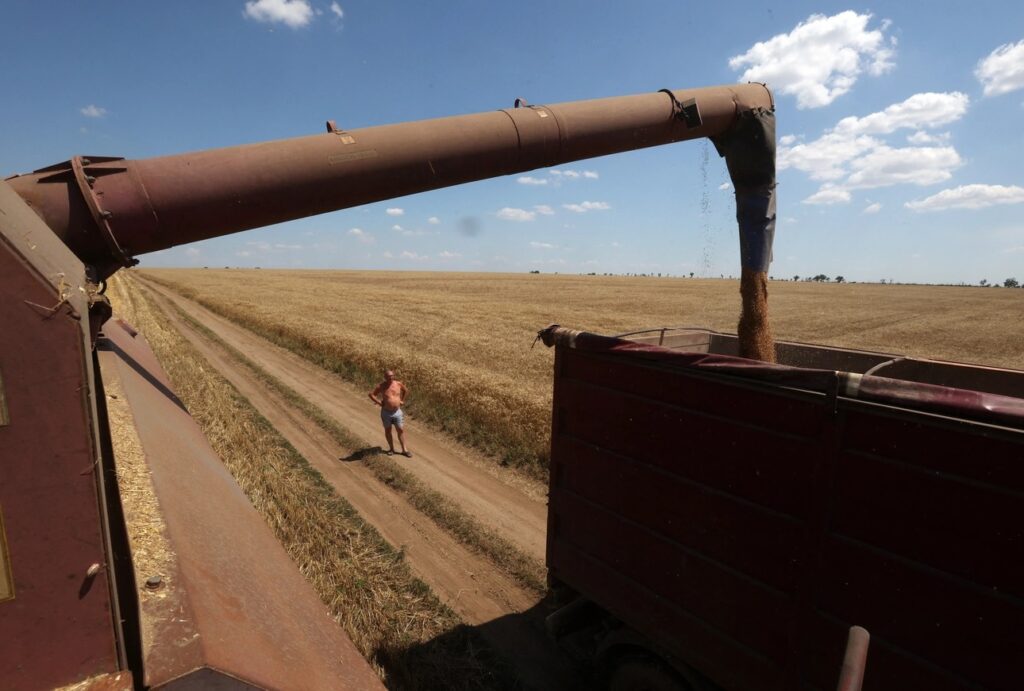July begins the Ukrainian wheat harvest, and the stalks from the humus-saturated soil near the Black Sea are chest-high and golden. A 20-minute car ride separates the port city of Odesa from wheat fields that, aside from a line of low trees, extend north and east without visible end. The only natural sound is a loud whisper the wind elicits every minute or so from the expanse of grain.
But it isn’t a time of plenty in the breadbasket of Europe, and not only because Russia, for now, says it won’t continue the arrangement it made with the United Nations and Turkey that for a year permitted 32 million tons of Ukrainian grain to be exported from the country’s massive southern ports. The present war has stunted Ukraine’s grain industry at every stage, beginning months before harvest time.
Though blessed with an abundance of wheat-friendly chernozem — the Russian term for “black earth” — most Ukrainians fertilize their soil. “There’s a great shortage of nitrogen fertilizers,” says Denis Tkachenko,who helps run a trade association of Odesa region farms including about 12,000 acres. Fertilization means more grain enriched with the proteins enabling wheat to be baked into bread; poorer crops can be sold more cheaply for animal feed.
Before the war, Russia was a large exporter of fertilizer and also of ammonium, which is essential to the fertilizers used by farmers like those Tkachenko represents. Ukraine has some capacity to synthesize fertilizer for itself, but two of its major fertilizer plants are now controlled by Russia. The price of fertilizer shot up after the February 2022 invasion (and Russia’s temporary decision not to export any of its own) and has since come down, but not enough, Tkachenko says, for farmers to afford enough for every field.
And there are many fewer fields. More than a quarter of Ukraine’s grain country lies east of the Dnieper River, and has been controlled or threatened by Russia since the February 2022 invasion. Even in the relatively safe southwest, the Ukrainian military has commandeered — thereby disabling — a lot of farmland. Tkachenko says that about 3 to 5 percent of the fields in his region were fortified early in the war against a possible Russian sea invasion. Another farmer in the area tells me that a third of his nearly 10,000 acres have been used for trenches, mining and the like.
Russia’s decision not to renew the U.N. Grain Initiative is painful to the industry, but even while the grain corridor functioned, Ukrainian farmers, merchants and officials reconsidered how to produce and to move the 40 percent of exports that 14 percent of the country’s labor force grows in fields. Forty percent of the agricultural total is grain — mostly corn, wheat, and barley — which for generations has departed Ukraine’s giant southern ports into the Black Sea, now patrolled by a hostile Russian navy. In 2021, Ukraine produced over 30 million tons of wheat, 9 million tons of barley, and over 40 million tons of corn — high numbers that declined by a third in 2022 and are expected to go down further in 2023.
Wartime changes to the grain industry — likely to be hastened by Russia’s withdrawal from the grain deal — have been costly to farmers and to the country, which now finds itself in an unpleasant economic competition with friendly wartime neighbors like Poland and Romania. Shortages of land and labor combined with decent harvests elsewhere compelled many Ukrainian farmers to sell crops at a loss.
For farmers who’ve been able to work their land, the largest challenge has been transportation. Before the present conflict, nearly all grain left Ukraine through major ports on the Black Sea. Over the past 12 months, a third has instead traveled on trucks over narrow highways to river barges on the Danube River, or ports in Poland and Romania, where local workers resent competition from Ukrainian crops and truckers.
Because so much of Ukraine’s economy depends on agriculture generally and on grain specifically, how the country manages the current grain crisis will help determine whether it can both profitably grow food within its borders and remain popular outside them, even once the war is over.
Source : Politico


